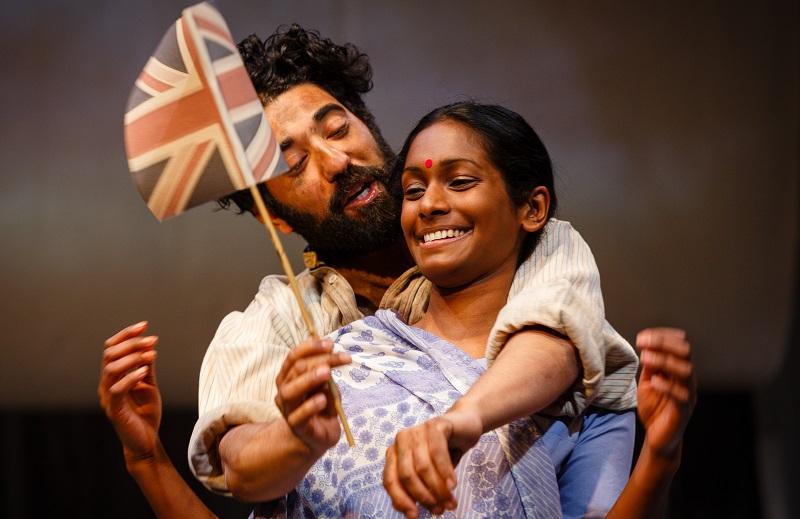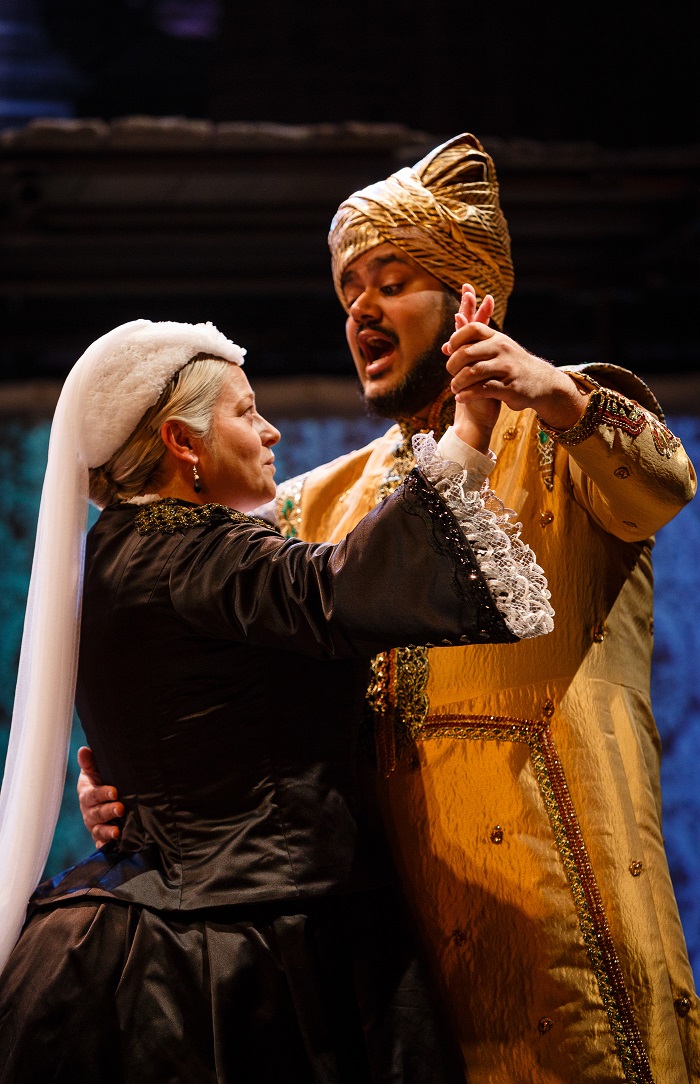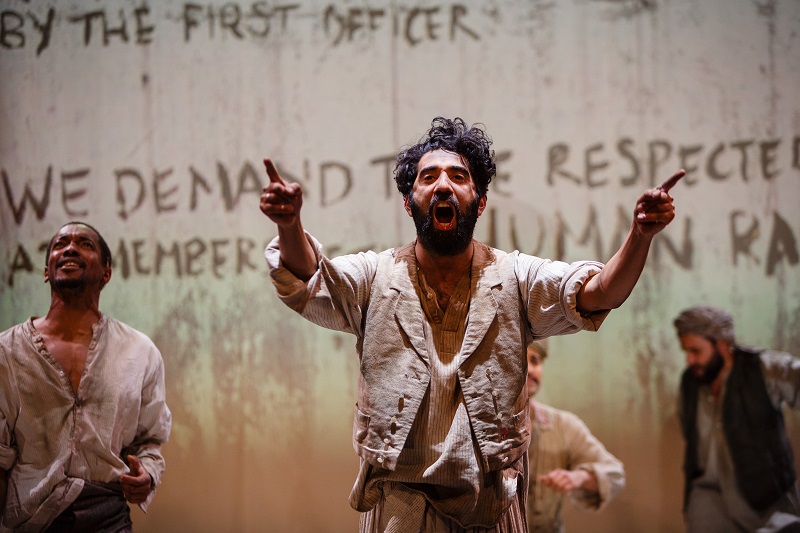Ayahs, lascars and munshis: staging The Empress | reviews, news & interviews
Ayahs, lascars and munshis: staging The Empress
Ayahs, lascars and munshis: staging The Empress
Tanika Gupta introduces her new play for the RSC about the Asian presence in Victorian England

It was over four years ago that I was commissioned by Michael Boyd, then artistic director of the RSC, to write a play which I had vaguely pitched to him as “a costume drama set in the nineteenth century with Asians running around in it”. And here we are, finally, about to open an epic and ambitious play set over the last 14 years of Queen Victoria’s reign.
Research in the British Library led me in many directions and I began to uncover a history that I wasn’t fully aware of before. I’d heard of Indian princes being introduced at Court, but wasn’t aware of how many other Indians were living and working in Britain. There was Abdul Karim, gifted to Queen Victoria (by the Viceroy of India) to celebrate her Golden Jubilee in 1887 - who became the old monarch’s beloved Munshi (teacher) to the end of her life. (Pictured below, Beatie Edney as Queen Victoria and Tony Jayawardena as Abdul Karim.)
 And there was Dadabhai Naoroji, the first ever Indian MP, elected in 1892 in Gladstone’s Liberal government. There were young men who came as students, particularly to study British law, and of course there were the Indian ayahs who served as nannies and nurse maids to the many colonial families, both in India and Britain.
And there was Dadabhai Naoroji, the first ever Indian MP, elected in 1892 in Gladstone’s Liberal government. There were young men who came as students, particularly to study British law, and of course there were the Indian ayahs who served as nannies and nurse maids to the many colonial families, both in India and Britain.
Meanwhile, all around the London docks were Indian lascars (sailors) who worked on the British steamers which sailed all over the British Empire. They were not slaves (as we all know, William Wilberforce abolished slavery in 1833) but they were often abused, underfed, flogged and made to work in appalling conditions. All these different “birds of passage” ended up in London and many laid down roots two generations or more before the Asian immigration that is more widely known and recorded.
My play The Empress follows characters from all these walks of life, inter-weaving their stories and looking at the personal and the political relationships of India and Britain in the heyday of British colonial rule. I had a wonderful time discovering how Queen Victoria learnt to speak and even read Hindi from Abdul Karim. I became increasingly interested in her double standards – at once championing the rights of her Indian servants, even calling her court “racialists”, while also revelling in her title Empress of India and happy to pursue the ruinous exploitation of countries she never visited. The 1890s saw the scramble for African colonies - while in India, the jewel of the colonial crown, there was a growing nationalist consciousness with a rising demand for Indian Home Rule championed in London by Dadabhai Naoroji. Both Gandhi and Mohammad Ali Jinnah were very young men in the early 1890s, studying law: both were mentored by Naoroji and called to the Bar.
 Michael Boyd put me together with the inspirational director Emma Rice who has a wonderful track record of devising work through her company Kneehigh. She had not worked with many text-based plays before but we had formed a creative understanding working together on the musical Wah! Wah! Girls in 2012 and her passion for working on The Empress was astonishing. From the start Emma’s vision of the world of the play was very modern, which I appreciated. In our early readings, including one at Osborne House on the Isle of Wight, the royal home created by Victoria and Albert where the queen spent her holidays with Abdul Karim, the play leapt off the page. (Pictured above left, Ray Panthaki)
Michael Boyd put me together with the inspirational director Emma Rice who has a wonderful track record of devising work through her company Kneehigh. She had not worked with many text-based plays before but we had formed a creative understanding working together on the musical Wah! Wah! Girls in 2012 and her passion for working on The Empress was astonishing. From the start Emma’s vision of the world of the play was very modern, which I appreciated. In our early readings, including one at Osborne House on the Isle of Wight, the royal home created by Victoria and Albert where the queen spent her holidays with Abdul Karim, the play leapt off the page. (Pictured above left, Ray Panthaki)
Emma has brought a unique flair to visualising these rich stories, seamlessly moving the action from the grimy East End docks to Victoria’s glittering palace. In her hands the characters explode to life and every scene buzzes with movement and dynamism. The result is not a stuffy costume drama, but a magical world, at once epic in scale and private in intimate moments - where an unknown history is revealed through songs, music, movement, words and action.
Share this article
The future of Arts Journalism
You can stop theartsdesk.com closing!
We urgently need financing to survive. Our fundraising drive has thus far raised £49,000 but we need to reach £100,000 or we will be forced to close. Please contribute here: https://gofund.me/c3f6033d
And if you can forward this information to anyone who might assist, we’d be grateful.

Subscribe to theartsdesk.com
Thank you for continuing to read our work on theartsdesk.com. For unlimited access to every article in its entirety, including our archive of more than 15,000 pieces, we're asking for £5 per month or £40 per year. We feel it's a very good deal, and hope you do too.
To take a subscription now simply click here.
And if you're looking for that extra gift for a friend or family member, why not treat them to a theartsdesk.com gift subscription?
more Theatre
 The Line of Beauty, Almeida Theatre review - the 80s revisited in theatrically ravishing form
Alan Hollinghurst novel is cunningly filleted, very finely acted
The Line of Beauty, Almeida Theatre review - the 80s revisited in theatrically ravishing form
Alan Hollinghurst novel is cunningly filleted, very finely acted
 Wendy & Peter Pan, Barbican Theatre review - mixed bag of panto and comic play, turned up to 11
The RSC adaptation is aimed at children, though all will thrill to its spectacle
Wendy & Peter Pan, Barbican Theatre review - mixed bag of panto and comic play, turned up to 11
The RSC adaptation is aimed at children, though all will thrill to its spectacle
 Hedda, Orange Tree Theatre review - a monument reimagined, perhaps even improved
Scandinavian masterpiece transplanted into a London reeling from the ravages of war
Hedda, Orange Tree Theatre review - a monument reimagined, perhaps even improved
Scandinavian masterpiece transplanted into a London reeling from the ravages of war
 The Assembled Parties, Hampstead review - a rarity, a well-made play delivered straight
Witty but poignant tribute to the strength of family ties as all around disintegrates
The Assembled Parties, Hampstead review - a rarity, a well-made play delivered straight
Witty but poignant tribute to the strength of family ties as all around disintegrates
 Mary Page Marlowe, Old Vic review - a starry portrait of a splintered life
Tracy Letts's Off Broadway play makes a shimmeringly powerful London debut
Mary Page Marlowe, Old Vic review - a starry portrait of a splintered life
Tracy Letts's Off Broadway play makes a shimmeringly powerful London debut
 Little Brother, Soho Theatre review - light, bright but emotionally true
This Verity Bargate Award-winning dramedy is entertaining as well as thought provoking
Little Brother, Soho Theatre review - light, bright but emotionally true
This Verity Bargate Award-winning dramedy is entertaining as well as thought provoking
 The Unbelievers, Royal Court Theatre - grimly compelling, powerfully performed
Nick Payne's new play is amongst his best
The Unbelievers, Royal Court Theatre - grimly compelling, powerfully performed
Nick Payne's new play is amongst his best
 The Maids, Donmar Warehouse review - vibrant cast lost in a spectacular-looking fever dream
Kip Williams revises Genet, with little gained in the update except eye-popping visuals
The Maids, Donmar Warehouse review - vibrant cast lost in a spectacular-looking fever dream
Kip Williams revises Genet, with little gained in the update except eye-popping visuals
 Ragdoll, Jermyn Street Theatre review - compelling and emotionally truthful
Katherine Moar returns with a Patty Hearst-inspired follow up to her debut hit 'Farm Hall'
Ragdoll, Jermyn Street Theatre review - compelling and emotionally truthful
Katherine Moar returns with a Patty Hearst-inspired follow up to her debut hit 'Farm Hall'
 Troilus and Cressida, Globe Theatre review - a 'problem play' with added problems
Raucous and carnivalesque, but also ugly and incomprehensible
Troilus and Cressida, Globe Theatre review - a 'problem play' with added problems
Raucous and carnivalesque, but also ugly and incomprehensible
 Clarkston, Trafalgar Theatre review - two lads on a road to nowhere
Netflix star, Joe Locke, is the selling point of a production that needs one
Clarkston, Trafalgar Theatre review - two lads on a road to nowhere
Netflix star, Joe Locke, is the selling point of a production that needs one
 Ghost Stories, Peacock Theatre review - spirited staging but short on scares
Impressive spectacle saves an ageing show in an unsuitable venue
Ghost Stories, Peacock Theatre review - spirited staging but short on scares
Impressive spectacle saves an ageing show in an unsuitable venue

Add comment